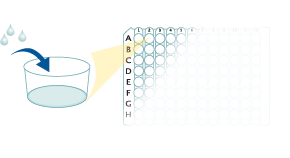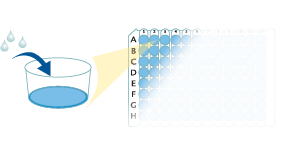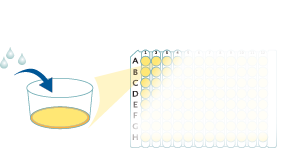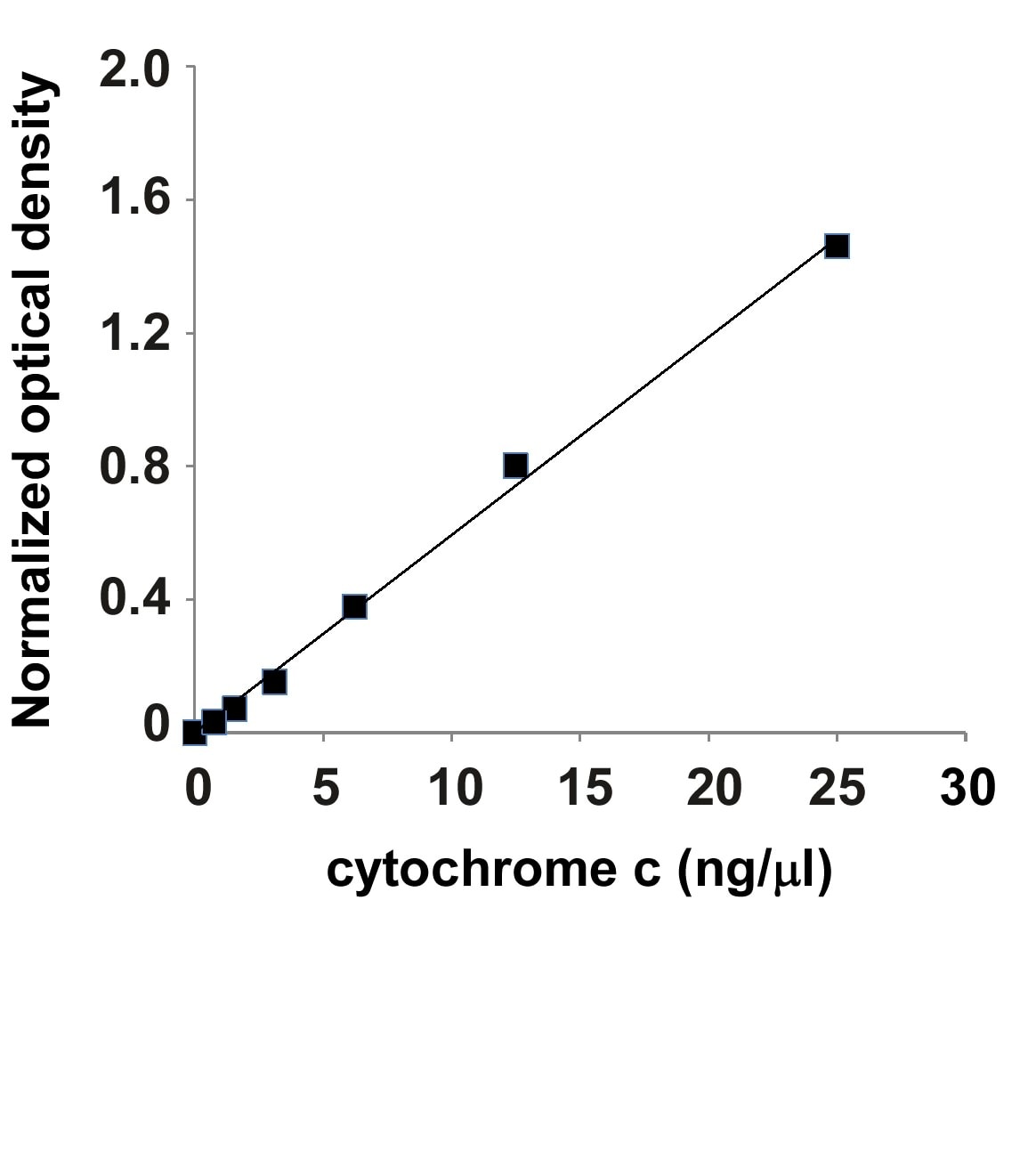Rat/Mouse Cytochrome c Quantikine ELISA Kit Summary
Product Summary
Precision
Cell Lysates, Subcellular Fractions
| Intra-Assay Precision | Inter-Assay Precision | |||||
|---|---|---|---|---|---|---|
| Sample | 1 | 2 | 3 | 1 | 2 | 3 |
| n | 20 | 20 | 20 | 20 | 20 | 20 |
| Mean (pg/mL) | 1.61 | 8.82 | 13.4 | 1.72 | 8.91 | 13.5 |
| Standard Deviation | 0.02 | 0.09 | 0.19 | 0.06 | 0.31 | 0.59 |
| CV% | 1.24 | 1.02 | 1.42 | 3.49 | 3.48 | 4.37 |
Recovery
The recovery of rat/mouse Cytochrome c spiked to three levels throughout the range of the assay in various matrices was evaluated.
| Sample Type | Average % Recovery | Range % |
|---|---|---|
| PBS/0.01% Saponin (n=2) | 94 | 90-98 |
| PBS/0.05% Tween 20 (n=2) | 101 | 100-102 |
| PBS/0.5% Triton X-100 (n=2) | 100 | 96-106 |
| PBS/1% Triton X-100 (n=2) | 98 | 95-101 |
Linearity
Scientific Data
Product Datasheets
Preparation and Storage
Background: Cytochrome c
Cytochrome c is a small, highly conserved, heme-containing protein involved in mitochondrial electron transport. Cytochrome c is released from the mitochondria in response to pro-apoptotic stimuli and serves as a cofactor in initiating the activation of the APAF-1/Caspase-9 complex. The effect of specific proteins and/or small molecules on the initiation of the intrinsic apoptotic pathway can be evaluated in an in vitro system of isolated mitochondria by monitoring the release of cytochrome c.
Assay Procedure
Refer to the product- Prepare all reagents, standard dilutions, and samples as directed in the product insert.
- Remove excess microplate strips from the plate frame, return them to the foil pouch containing the desiccant pack, and reseal.
- Add 75 µL of Conjugate to each well.
- Add 50 µL of Standard, Control, or sample to each well. Cover with a plate sealer, and incubate at room temperature for 2 hours.
- Aspirate each well and wash, repeating the process 4 times for a total of 5 washes.
- Add 100 µL Substrate Solution to each well. Incubate at room temperature for 30 minutes. PROTECT FROM LIGHT.
- Add 100 µL of Stop Solution to each well. Read at 450 nm within 30 minutes. Set wavelength correction to 540 nm or 570 nm.




Citations for Rat/Mouse Cytochrome c Quantikine ELISA Kit
R&D Systems personnel manually curate a database that contains references using R&D Systems products. The data collected includes not only links to publications in PubMed, but also provides information about sample types, species, and experimental conditions.
35
Citations: Showing 1 - 10
Filter your results:
Filter by:
-
Cardiotoxicity of chloroquine and hydroxychloroquine through mitochondrial pathway
Authors: E Seydi, M Karbalay, S Naderpour, A Arjmand, J Pourahmad
Bmc Pharmacology & Toxicology, 2023-04-21;24(1):26.
Species: Rat
Sample Types:
-
Neuroinflammation, Oxidative Stress, Apoptosis, Microgliosis and Astrogliosis in the Cerebellum of Mice Chronically Exposed to Waterpipe Smoke
Authors: Hamadi, N;Beegam, S;Zaaba, NE;Elzaki, O;Altamimi, MA;Nemmar, A;
Biomedicines
Species: Mouse
Sample Types: Tissue Homogenates
-
Gastroprotective effect of dapagliflozin in ethanol-induced gastric lesions in rats: Crosstalk between HMGB1/RAGE/PTX3 and TLR4/MyD88/VEGF/PDGF signaling pathways
Authors: RM Salama, RH Ahmed, AA Farid, BA AbdElSatta, RM AbdelBaset, ME Youssef, SA El Wakeel
International immunopharmacology, 2023-01-07;115(0):109686.
Species: Rat
Sample Types: Tissue Homogenates
-
Sex differences in the inflammatory response of the mouse DRG and its connection to pain in experimental autoimmune encephalomyelitis
Authors: AD Maguire, TN Friedman, DN Villarreal, F Haq, J Dunn, K Pfeifle, G Tenorio, K Buro, JR Plemel, BJ Kerr
Scientific Reports, 2022-12-05;12(1):20995.
Species: Mouse
Sample Types: Cell Lysates
-
Strategy to Enhance Anticancer Activity and Induced Immunogenic Cell Death of Antimicrobial Peptides by Using Non-Nature Amino Acid Substitutions
Authors: YH Cheah, CY Liu, BS Yip, CL Wu, KL Peng, JW Cheng
Biomedicines, 2022-05-09;10(5):.
Species: Human
Sample Types: Cell Culture Supernates
-
The conformational stability of pro-apoptotic BAX is dictated by discrete residues of the protein core
Authors: NB Bloch, TE Wales, MS Prew, HR Levy, JR Engen, LD Walensky
Nature Communications, 2021-08-13;12(1):4932.
Species: Mouse
Sample Types: Cell Culture Supernates
-
Aldosterone Excess Induced Mitochondria Decrease and Dysfunction via Mineralocorticoid Receptor and Oxidative Stress In Vitro and In Vivo
Authors: CH Tsai, CT Pan, YY Chang, SY Peng, PC Lee, CW Liao, CT Shun, PT Li, VC Wu, CH Chou, IJ Tsai, CS Hung, YH Lin
Biomedicines, 2021-08-02;9(8):.
Species: Rat
Sample Types: Cell Lysates
-
Inhibition of miR-134-5p protects against kainic acid-induced excitotoxicity through Sirt3-mediated preservation of mitochondrial function
Authors: W Lin, X Qian, LK Yang, J Zhu, D Wang, CH Hang, Y Wang, T Chen
Epilepsy research, 2021-07-12;176(0):106722.
Species: Mouse
Sample Types: Cell Lysates
-
Eltrombopag directly inhibits BAX and prevents cell death
Authors: AZ Spitz, E Zacharioud, DE Reyna, TP Garner, E Gavathioti
Nature Communications, 2021-02-18;12(1):1134.
Species: Mouse
Sample Types: Cell Culture Supernates
-
Toxic oligomers of the amyloidogenic HypF-N protein form pores in mitochondrial membranes
Authors: MY Farrugia, M Caruana, S Ghio, A Camilleri, C Farrugia, RJ Cauchi, S Cappelli, F Chiti, N Vassallo
Sci Rep, 2020-10-20;10(1):17733.
Species: Human
Sample Types: Cell Culture Supernates
-
Verapamil Inhibits Mitochondria-Induced Reactive Oxygen Species and Dependent Apoptosis Pathways in Cerebral Transient Global Ischemia/Reperfusion
Authors: E Jangholi, ZN Sharifi, M Hoseinian, MR Zarrindast, HR Rahimi, A Mowla, H Aryan, MA Javidi, Y Parsa, F Ghaffarpas, S Yadollah-D, HZ Arani, F Shahi, S Movassaghi
Oxid Med Cell Longev, 2020-10-17;2020(0):5872645.
Species: Rat
Sample Types: Cell Lysates
-
Site-Dependent Cysteine Lipidation Potentiates the Activation of Proapoptotic BAX
Authors: DT Cohen, TE Wales, MW McHenry, JR Engen, LD Walensky
Cell Rep, 2020-03-10;30(10):3229-3239.e6.
Species: Mouse
Sample Types: Cell Culture Supernates
-
High Concentration of C5a-Induced Mitochondria-Dependent Apoptosis in Murine Kidney Endothelial Cells
Authors: IJ Tsai, WC Lin, YH Yang, YL Tseng, YH Lin, CH Chou, YK Tsau
Int J Mol Sci, 2019-09-10;20(18):.
Species: Mouse
Sample Types: Cell Culture Supernates
-
A Comparison of Mitochondrial Toxicity of Mephedrone on three Separate Parts of Brain including Hippocampus, Cortex and Cerebellum
Authors: P Naserzadeh, G Taghizadeh, B Atabaki, E Seydi, J Pourahmad
Neurotoxicology, 2019-02-22;0(0):.
Species: Rat
Sample Types: Subcellular Fraction
-
Epigallocatechin-3-gallate attenuates microcystin-LR-induced apoptosis in human umbilical vein endothelial cells through activation of the NRF2/HO-1 pathway
Authors: J Shi, M Zhang, L Zhang, H Deng
Environ. Pollut., 2018-04-19;239(0):466-472.
Species: Human
Sample Types: Cell Lysates
-
Epigallocatechin-3-gallate counters cisplatin toxicity of rat testes
Authors: AA Fouad, HO Qutub, AEA Fouad, AM Audeh, WN Al-Melhim
Pharm Biol, 2017-12-01;55(1):1710-1714.
Species: Rat
Sample Types: Tissue Homogenates
-
microRNA dysregulation in polyglutamine toxicity of TATA-box�binding protein is mediated through STAT1 in mouse neuronal cells
Authors: R Roshan, A Choudhary, A Bhambri, B Bakshi, T Ghosh, B Pillai
J Neuroinflammation, 2017-08-03;14(1):155.
Species: Mouse
Sample Types: Cell Lysates
-
Allicin Decreases Lipopolysaccharide-Induced Oxidative Stress and Inflammation in Human Umbilical Vein Endothelial Cells through Suppression of Mitochondrial Dysfunction and Activation of Nrf2
Authors: M Zhang, H Pan, Y Xu, X Wang, Z Qiu, L Jiang
Cell. Physiol. Biochem., 2017-04-26;41(6):2255-2267.
Species: Human
Sample Types: Cell Culture Supernates
-
Di-Huang-Yi-Zhi herbal formula attenuates amyloid-?-induced neurotoxicity in PC12 cells
Authors: HM An, C Lin, C Gu, JJ Chen, WX Sun, M Jin, TL Zhang, MF Qiu, B Hu
Exp Ther Med, 2017-04-20;13(6):3003-3008.
Species: Rat
Sample Types: Cell Lysates
-
A Small-Molecule Inhibitor of Bax and Bak Oligomerization Prevents Genotoxic Cell Death and Promotes Neuroprotection
Authors: X Niu, H Brahmbhatt, P Mergenthal, Z Zhang, J Sang, M Daude, FG Ehlert, WE Diederich, E Wong, W Zhu, J Pogmore, JP Nandy, M Satyanaray, RK Jimmidi, P Arya, B Leber, J Lin, C Culmsee, J Yi, DW Andrews
Cell Chem Biol, 2017-04-06;0(0):.
Species: Mouse
Sample Types: Cell Lysates
-
Repeated Administration of Mercury Intensifies Brain Damage in Multiple Sclerosis through Mitochondrial Dysfunction
Authors: F Kahrizi, A Salimi, F Noorbakhsh, M Faizi, F Mehri, P Naserzadeh, N Naderi, J Pourahmad
Iran J Pharm Res, 2016-01-01;15(4):834-841.
Species: Mouse
Sample Types: Cell Culture Supernates
-
Interleukin-1beta enhances FasL-induced caspase-3/-7 activity without increasing apoptosis in primary mouse hepatocytes.
Authors: Lutz A, Sanwald J, Thomas M, Feuer R, Sawodny O, Ederer M, Borner C, Humar M, Merfort I
PLoS ONE, 2014-12-31;9(12):e115603.
Species: Mouse
Sample Types: Cell Culture Supernates
-
Paeoniflorin inhibition of 6-hydroxydopamine-induced apoptosis in PC12 cells via suppressing reactive oxygen species-mediated PKCdelta/NF-kappaB pathway.
Authors: Dong H, Li R, Yu C, Xu T, Zhang X, Dong M
Neuroscience, 2014-11-18;285(0):70-80.
Species: Rat
Sample Types: Cell Lysates
-
Sirt3 protects cortical neurons against oxidative stress via regulating mitochondrial Ca2+ and mitochondrial biogenesis.
Authors: Dai, Shu-Hui, Chen, Tao, Wang, Yu-Hai, Zhu, Jie, Luo, Peng, Rao, Wei, Yang, Yue-Fan, Fei, Zhou, Jiang, Xiao-Fan
Int J Mol Sci, 2014-08-21;15(8):14591-609.
Species: Rat
Sample Types: Cell Lysates
-
After embedding in membranes antiapoptotic Bcl-XL protein binds both Bcl-2 homology region 3 and helix 1 of proapoptotic Bax protein to inhibit apoptotic mitochondrial permeabilization.
Authors: Ding J, Mooers B, Zhang Z, Kale J, Falcone D, McNichol J, Huang B, Zhang X, Xing C, Andrews D, Lin J
J Biol Chem, 2014-03-10;289(17):11873-96.
Species: Mouse
Sample Types: Cell Culture Supernates
-
Dynamin-related protein 1 inhibitors protect against ischemic toxicity through attenuating mitochondrial Ca2+ uptake from endoplasmic reticulum store in PC12 cells.
Authors: Tian, Ye, Li, Bin, Shi, Wen-Zhen, Chang, Ming-Ze, Zhang, Ge-Juan, Di, Zheng-Li, Liu, Yong
Int J Mol Sci, 2014-02-21;15(2):3172-85.
Species: Rat
Sample Types: Cell Culture Supernates
-
Inhibition of store-operated calcium entry attenuates MPP(+)-induced oxidative stress via preservation of mitochondrial function in PC12 cells: involvement of Homer1a.
Authors: Li X, Chen W, Zhang L, Liu W, Fei Z
PLoS ONE, 2013-12-17;8(12):e83638.
Species: Rat
Sample Types: Mitochondria
-
Iduna protects HT22 cells from hydrogen peroxide-induced oxidative stress through interfering poly(ADP-ribose) polymerase-1-induced cell death (parthanatos).
Authors: Xu H, Luo P, Zhao Y, Zhao M, Yang Y, Chen T, Huo K, Han H, Fei Z
Cell Signal, 2013-01-16;25(4):1018-26.
Species: Rat
Sample Types: Cell Lysates
-
Rapid detection of an ABT-737-sensitive primed for death state in cells using microplate-based respirometry.
Authors: Clerc, Pascalin, Carey, Gregory, Mehrabian, Zara, Wei, Michael, Hwang, Hyehyun, Girnun, Geoffrey, Chen, Hegang, Martin, Stuart S, Polster, Brian M
PLoS ONE, 2012-08-03;7(8):e42487.
Species: Mouse
Sample Types: Cell Lysates
-
Antimitochondrial autoantibodies in pemphigus vulgaris: a missing link in disease pathophysiology.
Authors: Marchenko S, Chernyavsky AI, Arredondo J, Gindi V, Grando SA
J. Biol. Chem., 2009-12-10;285(6):3695-704.
Species: Mouse
Sample Types: Cell Lysates
-
Augmenter of liver regeneration: an important intracellular survival factor for hepatocytes.
Authors: Thirunavukkarasu C, Wang LF, Harvey SA, Watkins SC, Chaillet JR, Prelich J, Starzl TE, Gandhi CR
J. Hepatol., 2008-01-28;48(4):578-88.
Species: Mouse
Sample Types: Cell Lysates
-
Mitochondrially targeted ceramide LCL-30 inhibits colorectal cancer in mice.
Authors: Dahm F, Bielawska A, Nocito A, Georgiev P, Szulc ZM, Bielawski J, Jochum W, Dindo D, Hannun YA, Clavien PA
Br. J. Cancer, 2007-11-20;98(1):98-105.
Species: Mouse
Sample Types: Cell Lysates
-
Cardiomyocyte-specific Bcl-2 overexpression attenuates ischemia-reperfusion injury, immune response during acute rejection, and graft coronary artery disease.
Authors: Tanaka M, Nakae S, Terry RD, Mokhtari GK, Gunawan F, Balsam LB, Kaneda H, Kofidis T, Tsao PS, Robbins RC
Blood, 2004-07-27;104(12):3789-96.
Species: Mouse
Sample Types: Cell Lysates
-
Release of intact, monomeric cytochrome c from apoptotic and necrotic cells.
Authors: Jemmerson R, LaPlante B, Treeful A
Cell Death Differ., 2002-05-01;9(5):538-48.
Species: Mouse
Sample Types: Cell Culture Supernates
-
Posttranslational N-myristoylation of BID as a molecular switch for targeting mitochondria and apoptosis.
Authors: Zha J, Weiler S, Oh KJ, Wei MC, Korsmeyer SJ
Science, 2000-12-01;290(5497):1761-5.
Species: Mouse
Sample Types: Tissue Homogenates
FAQs
No product specific FAQs exist for this product, however you may
View all ELISA FAQsReviews for Rat/Mouse Cytochrome c Quantikine ELISA Kit
Average Rating: 5 (Based on 1 Review)
Have you used Rat/Mouse Cytochrome c Quantikine ELISA Kit?
Submit a review and receive an Amazon gift card.
$25/€18/£15/$25CAN/¥75 Yuan/¥2500 Yen for a review with an image
$10/€7/£6/$10 CAD/¥70 Yuan/¥1110 Yen for a review without an image
Filter by:







